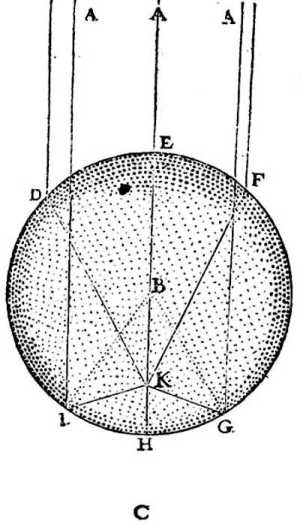The Appearance of Multiple Suns
Table of Contents
Sometimes other circles appear in the clouds, different from those I have mentioned.
They are always entirely white. Instead of having a star at their center, they usually intersect the center of the sun or the moon and seem parallel or almost parallel to the horizon.
I must explain both phenomena together because:
- they only appear in those large round clouds mentioned above
- several suns or moons can sometimes be seen in the same clouds
For example, let:
Abe noon, where the sun is accompanied by a warm wind blowing towardsBCbe the north, from where a cold wind also blows towardsB.

These 2 winds gather a cloud composed of snow particles.
- These extend so far in depth and width that they cannot pass over, under, or between each other as they usually do elsewhere.
- Instead they are forced to circulate all around it.
They round it out and the warm wind from the south partially melts the surrounding snow.
This snow is immediately refrozen by:
- the cold northern wind
- the proximity of the still unmelted inner snow.
It can form a large, continuous, and transparent ice ring. Its surface will be smooth due to the uniform winds that shape it.
The side DEF is exposed to the warm wind and the sun than the other side GHI where the snow could not melt as easily.
- The ice will be thicker on
DEF
This stormless air cannot have enough warmth around the cloud B to form such ice.
- There is also not enough heat from the earth below to create vapors that would lift up the cloud.
As a result, the noon sunlight strikes all around the ice DEFGHI.
- It reflects off of the whiteness of the nearby snow.
- This makes this snow appear to those below as a large, entirely white circle.
For this effect, the cloud must be:
- round and
- slightly more compressed around its circumference than in the middle, without the ice ring needing to be formed.